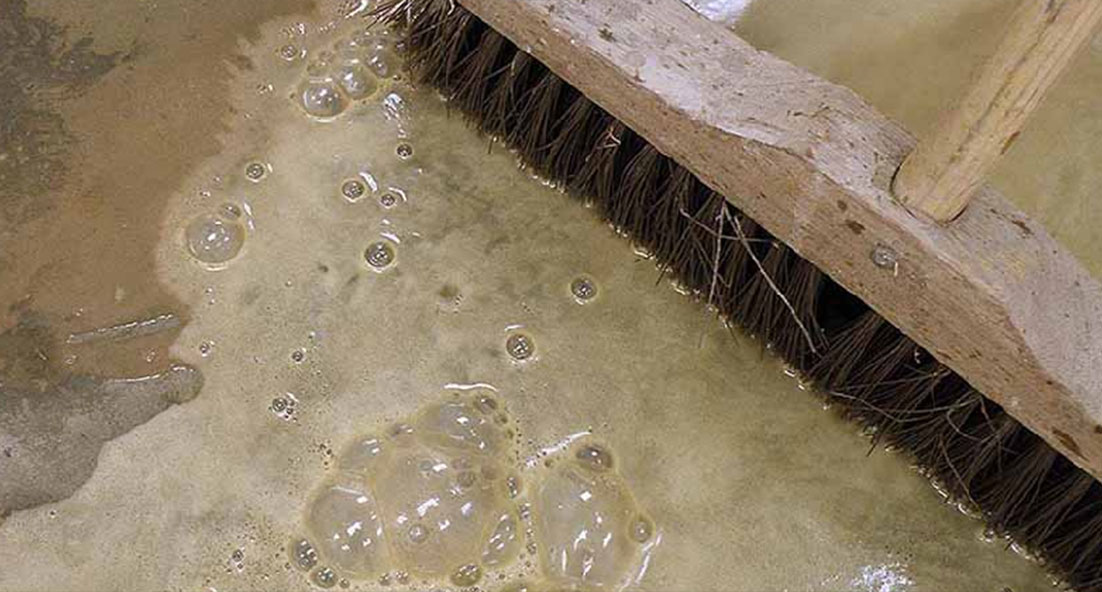
Chemical Cleaning
If you are an industrial user with a large area, then you may be better to consider mechanical preparation. However, for smaller areas / domestic users, an alternative method is with the use of an acid based solution – Polycote Etch IT
Acid Etching
Etch IT is a very low cost chemical method commonly used to treat concrete floors to remove laitance and provide a profile. The objective of acid etching is to dissolve the weak surface layer known as laitance and open the pores to allow penetration of the sealer coat.
Please note:
- Should you wish to remove greases, oils, or other types of contaminants, these can be treated with Polycote Degrease IT prior to the etching procedure.
- Acid Etching will not be effective over release agents and/or most surface hardeners.
- In sensitive situations, the use of phosphoric acid (which is non-volatile) could be considered as an alternative to Etch IT – which is a hydrochloric acid.
- Etch IT will be of no use whatsoever to a painted surface. It is only for use on bare concrete concrete and metal.
Pre-Dampen The Surface
Pre-dampen the surface with clean cold water taking care to remove any puddling areas or excess surface water. This dampening is only to remove the immediate suction of a dry surface as we do not want the acid soaking down into the substrate. The ‘treatment’ is only for the loose/friable material on the surface.
Diluting The Acid
Polycote Etch IT is a concentrated Hydrochloric Acid and should be diluted with water. The dilution ratio is normally 3 parts water to 1 part acid but can be both stronger or weaker, depending upon the quality / porosity of the concrete being treated.
Please note:
- When mixing the water and acid together, it is important to add the acid to the water – NOT he water to the acid.
- Should there only be a weak reaction of the acid solution, or an absence of bubbles altogether, this can be an indication of:
- The presence of a surface hardener – which will prevent the reaction of the acid
- The solution being too weak / concrete too hard. Increase the quantity of acid solution to the water until there IS a reaction on the surface.
Application
Using a relatively stiff broom, the diluted acid should then be applied uniformly over the surface. The acid will bubble and/or ‘fizz’ for the following 3-5 minutes during which you can scrub the surface with the broom to help facilitate the etching process. The bubbling/fizzing reaction of the solution indicates that the etching is indeed strong enough and is completing its work.
Once etching is completed – and BEFORE the surface has dried, wash the area thoroughly with fresh cold water to help remove the surface dust / loose material and also to neutralize the surface.
Brush the water out of the door and depending upon local regulations, this can now be washed down the normal drainage system. By the time it has been sent down the drain, it should have been well neutralized by the amount of water used to wash the floor. However, should you wish to be absolutely sure then simply send a goodly quantity of fresh clean water down the drain with the use of a hose pipe.
Please note that if the surface DOES dry before this washing process, it can allow the formation of salts on the surface and once formed, these salts are difficult to remove!
Scrubber / Drier
Alternatively, the use of a mechanical scrubber / drier is good for removing the water and debris, although take care to thoroughly wash out after use to ensure there be no degradation to the rubber seals, etc.
Result:
Properly etched concrete will leave the surface hard and slightly textured. More importantly, the pores will now be opened and thereby allow the subsequent treatment/coating to penetrate well into the surface.
Important:
- Both hydrochloric and phosphoric acids are commonly used in the preparation of floors. However, please do use with care as they can cause burns to skin and the inhalation of acid fumes can also cause discomfort. Using the correct personal protection, your job can be completed quickly, easily and safely
- As the pores of the concrete are now open, please make sure the area is not used / contaminated prior to sealing the floor with your chosen coating.
FURTHER TECHNICAL HELP REQUIRED?
Thank you for your interest and we hope you have found the above information both interesting and helpful. However, should you still have be unsure as to the best solution for your needs, please don’t hesitate to ring our technical helpline now on 01234 846400. We have a fully qualified team ready to give practical advice and help assist you as much as possible.
